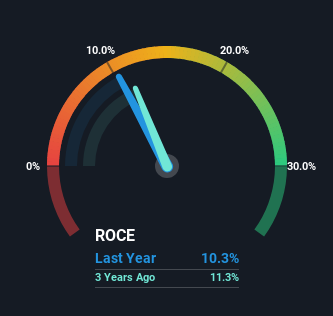- Taiwan
- /
- Electronic Equipment and Components
- /
- TWSE:8046
Investors Will Want Nan Ya Printed Circuit Board's (TWSE:8046) Growth In ROCE To Persist

What trends should we look for it we want to identify stocks that can multiply in value over the long term? Firstly, we'll want to see a proven return on capital employed (ROCE) that is increasing, and secondly, an expanding base of capital employed. If you see this, it typically means it's a company with a great business model and plenty of profitable reinvestment opportunities. With that in mind, we've noticed some promising trends at Nan Ya Printed Circuit Board (TWSE:8046) so let's look a bit deeper.
Understanding Return On Capital Employed (ROCE)
Just to clarify if you're unsure, ROCE is a metric for evaluating how much pre-tax income (in percentage terms) a company earns on the capital invested in its business. To calculate this metric for Nan Ya Printed Circuit Board, this is the formula:
Return on Capital Employed = Earnings Before Interest and Tax (EBIT) ÷ (Total Assets - Current Liabilities)
0.10 = NT$6.3b ÷ (NT$70b - NT$9.1b) (Based on the trailing twelve months to December 2023).
Therefore, Nan Ya Printed Circuit Board has an ROCE of 10%. In absolute terms, that's a satisfactory return, but compared to the Electronic industry average of 6.9% it's much better.
Check out our latest analysis for Nan Ya Printed Circuit Board

Above you can see how the current ROCE for Nan Ya Printed Circuit Board compares to its prior returns on capital, but there's only so much you can tell from the past. If you'd like, you can check out the forecasts from the analysts covering Nan Ya Printed Circuit Board for free.
What Does the ROCE Trend For Nan Ya Printed Circuit Board Tell Us?
Nan Ya Printed Circuit Board has recently broken into profitability so their prior investments seem to be paying off. The company was generating losses five years ago, but now it's earning 10% which is a sight for sore eyes. In addition to that, Nan Ya Printed Circuit Board is employing 82% more capital than previously which is expected of a company that's trying to break into profitability. This can tell us that the company has plenty of reinvestment opportunities that are able to generate higher returns.
The Bottom Line On Nan Ya Printed Circuit Board's ROCE
To the delight of most shareholders, Nan Ya Printed Circuit Board has now broken into profitability. And with the stock having performed exceptionally well over the last five years, these patterns are being accounted for by investors. With that being said, we still think the promising fundamentals mean the company deserves some further due diligence.
If you'd like to know about the risks facing Nan Ya Printed Circuit Board, we've discovered 2 warning signs that you should be aware of.
While Nan Ya Printed Circuit Board may not currently earn the highest returns, we've compiled a list of companies that currently earn more than 25% return on equity. Check out this free list here.
If you're looking to trade Nan Ya Printed Circuit Board, open an account with the lowest-cost platform trusted by professionals, Interactive Brokers.
With clients in over 200 countries and territories, and access to 160 markets, IBKR lets you trade stocks, options, futures, forex, bonds and funds from a single integrated account.
Enjoy no hidden fees, no account minimums, and FX conversion rates as low as 0.03%, far better than what most brokers offer.
Sponsored ContentValuation is complex, but we're here to simplify it.
Discover if Nan Ya Printed Circuit Board might be undervalued or overvalued with our detailed analysis, featuring fair value estimates, potential risks, dividends, insider trades, and its financial condition.
Access Free AnalysisHave feedback on this article? Concerned about the content? Get in touch with us directly. Alternatively, email editorial-team (at) simplywallst.com.
This article by Simply Wall St is general in nature. We provide commentary based on historical data and analyst forecasts only using an unbiased methodology and our articles are not intended to be financial advice. It does not constitute a recommendation to buy or sell any stock, and does not take account of your objectives, or your financial situation. We aim to bring you long-term focused analysis driven by fundamental data. Note that our analysis may not factor in the latest price-sensitive company announcements or qualitative material. Simply Wall St has no position in any stocks mentioned.
About TWSE:8046
Nan Ya Printed Circuit Board
Manufactures and sells printed circuit boards (PCBs) in Taiwan, the United States, Mainland China, Korea, and internationally.
Flawless balance sheet with reasonable growth potential.
Similar Companies
Market Insights
Community Narratives



